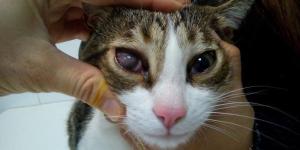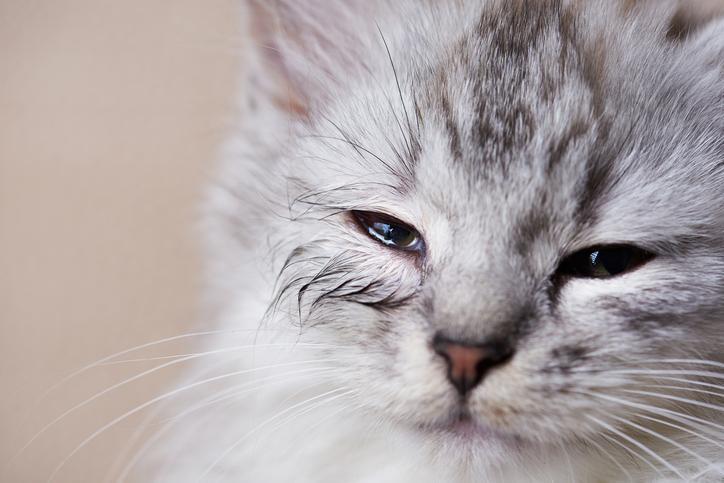Chlamydiosis in Cats - Symptoms and Treatment



See files for Cats
Feline chlamydiosis is a highly contagious bacterial disease caused by the pathogenic bacteria Chlamydia felis. Although its symptoms are most associated with problems in the cat's eyes, it can also affect many different parts of the cat's organism such as the genitals and upper respiratory tract. Also known as feline chlamydia, it can affect any cat at any time. However, it is most common in young felines and strays. The latter is partly because they have less preventive protection against disease, as well as the contagious nature of Chlamydia bacteria.
At AnimalWised, we help you detect chlamydiosis in cats by providing its symptoms and treatment. We look at the method of contagion by this bacteria, as well as what you can do to best prevent your cat getting feline chlamydia.
Chlamydiosis in cats contagious route
Also known as feline chlamydia, chlamydiosis in cats is caused by a type of gram-negative bacteria called Chlamydia felis. While Chlamydia felis is the main species of this bacteria which affects cats, they can be infected by others of the same genus such as Chlamydia psittaci. In fact, Chlamydia felis was once known as Chlamydia psittaci var. felis.
There are various symptoms associated with this bacterial infection, but conjunctivitis is one of the most typical. It is currently estimated that around 30% of feline conjunctivitis diagnoses are related to chlamydiosis. Furthermore, it has been reported that Chlamydia felis bacteria usually act in association with feline calicivirus and rhinotracheitis virus.
Chlamydia bacteria can remain dormant in the environment, but they need a host to reproduce. It is for this reason they enter the feline's body, where they find a ready availability of food and a safe environment to live. When they enter the cat's body, their incubation period ranges from 3 to 10 days.
The route of chlamydiosis contagion occurs through direct contact with the nasal and ocular secretions of infected cats. Cats that live in groups are especially vulnerable to this pathology due to their close proximity of living.
In the past, chlamydiosis was known as chlamydial conjunctivitis or feline pneumonitis, but this categorization is no longer commonly used. This is because it affects more than the conjunctiva of the cat's eyes, but it is also not very common for it to reach the lungs. It is much more common for these bacteria to infect the eyes and upper respiratory tract, resulting in prolonged conjunctivitis and eventual rhinitis.
Is chlamydiosis in cats contagious to humans?
Feline chlamydiosis cannot be transmitted to humans from infected cats if it is due to Chlamydia felis. This is because this bacteria cannot use humans as a host. It may be possible if they are infected by Chlamydia psittaci since this has greater zoonotic potential, i.e. it can be transferred from animals to humans. However, this is rare.
It is very important to reiterate that transmission is very easy between felines. This is especially worrying if you have more than one cat in the household, but cats with outdoor access can also infect other cats in the neighborhood.
If you see any symptom of potential chlamydiosis in your cat, you will need to take them to a veterinarian immediately. Not only will you need to reduce the impact of the bacteria on your cat's organism, but it will help spread potential outbreaks of the disease. You should be particularly considerate if you have adopted a stray cat or they have been in contact with cats that display potential symptoms of chlamydiosis.
We look at what the symptoms of feline chlamydia are in the next section.

Symptoms of chlamydiosis in cats
Generally speaking, the symptoms of feline chlamydia present the following:
- Excessive secretion: the first visible sign of feline chlamydiosis is a frequent watery discharge that may appear in one or both eyes. These are the first signs of any type of conjunctivitis in cats. Generally, the eyeball of affected cats has excessive moisture, making it tear constantly.
- Third eyelid showing: in many cases, redness and swelling of the cat's third eyelid are also seen.
- Eye discharge: if the disease is not treated quickly, the watery secretion becomes increasingly viscous and may be purulent. We will see it develop the greenish color typical of pus. At this stage, the cat becomes vulnerable to the formation of corneal ulcers and other ulcers around the eyes, as well as conjunctive edema.
- Generalized symptoms: as a result of their immune system battling the bacteria, their organism can be overwhelmed. Often fever, fatigue, loss of appetite and weight loss are common.
- Respiratory symptoms: in more advanced cases, the respiratory system may be compromised. The affected feline may have a runny nose and constant sneezing, which are generally caused by rhinitis sinus infection in cats.
As we have stated, the chlamydia infection rarely reaches the lungs of the cat. If this does occur, lung lesions are possible. These can only be observed in a clinical setting, but we may see the cat develop coughing as a result.
Treatment for chlamydiosis in cats
When you observe any of the above symptoms in your feline, it is essential to go to the veterinarian achieve a diagnosis of feline chlamydiosis. In the clinic, this professional will carry out the necessary clinical analyzes and diagnostic tests to differentiate between possible pathologies. If the diagnosis of feline chlamydiosis is confirmed, the treatment will depend on the state of health and the evolution of the pathology in each feline.
Antibiotics are generally essential to contain the reproduction and combat Chlamydia felis bacteria. They can be prescribed for oral, intravenous or ocular routes, the latter prepared in the form of eye drops. Antibiotics should only ever be prescribed by a medical professional. Self-medication of your cat is very dangerous and increases the resistance of bacteria, making the treatment of Chlamydia felis more difficult.
The two main types of antibiotic used to treat chlamydia in cats are the following:
- Azithromycin: a macrolide antibiotic which has a longer duration of action than most antibiotics. You can learn more with our guide to azithromycin for cats.
- Doxycycline: doxycycline for cats is a type of tetracycline antibiotic which said to be effective against this type of bacteria.
Even when prescribed antibiotics, affected cats may have sticky or dark discharge for days or even weeks. It will be important that you clean your kitten's eyes and nose daily until the secretion completely disappears. The veterinarian may indicate some specific wipes or simply provide a clean gauze slightly moistened with saline solution or warm water.
During treatment, it is essential that the affected cat be separated from other felines to avoid new infections. It will also be necessary to reinforce home hygiene by disinfecting the environment and objects used by felines. This is because bacteria can remain dormant in accessories, toys, litterboxes, scratching posts and other objects frequently used by cats.
Be careful with traditional cleaning products. The chemical substances in their formula can poison cats and irritate their mucous membranes. The ideal is to opt for ‘pet friendly’ antibacterial disinfectants, i.e. those made especially for homes with pets. These are usually enzymatic cleaning products.

Prevention of chlamydiosis in cats
The best way to prevent feline chlamydia is to offer adequate preventive medicine, a positive environment and the necessary care that allows your kitten to strengthen their immune system and preserve good health. To do this, it is essential to make regular visits to the veterinarian every 6 months, respect their vaccination schedule and provide periodic deworming.
It is also essential you provide them with a balanced diet indicated for their specific needs. If a cat has a lowered immune system and less resistance to bacterial problems, they may need immunity boosting supplements. These should be determined by veterinary consultation. Keep them physically and mentally stimulated throughout their lives. Do not hesitate to go to veterinarian when we see any change in our feline's appearance or behavior.
Sterilization may be recommended to prevent cats from escaping during their heat period. While feline chlamydia is a sexually transmitted disease in cats, it can also be transferred in many other ways. This includes fighting among males for territoriality. Spaying and neutering not only stops sexual behaviors, but it also reduces these types of aggressive, thereby limiting the spread of diseases such as chlamydia in cats.
Learn more about the benefits, price and other considerations when neutering a cat with our related guide.

This article is purely informative. AnimalWised does not have the authority to prescribe any veterinary treatment or create a diagnosis. We invite you to take your pet to the veterinarian if they are suffering from any condition or pain.
If you want to read similar articles to Chlamydiosis in Cats - Symptoms and Treatment, we recommend you visit our Eye problems category.







